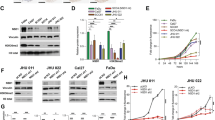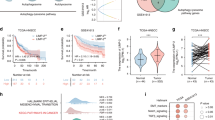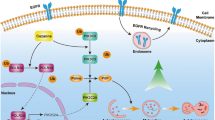Abstract
Epidermal growth factor receptor (EGFR)-targeted therapy in head and neck squamous cell carcinoma (HNSCC) patients frequently results in tumor resistance to treatment. Autophagy is an emerging underlying resistance mechanism, however, the molecular autophagy machinery in HNSCC cells and potential biomarkers of patient response to EGFR-targeted therapy remain insufficiently characterized. Here we show that the EGFR blocking with cetuximab leads to varied autophagic responses, which modulate cancer cell susceptibility to EGFR inhibition. Inhibition of autophagy sensitizes HNSCC cells to EGFR blockade. Importantly, we identify a novel signaling hub centering on the NLRX1 (nucleotide-binding, lots of leucine-rich repeats-containing protein member X1)–TUFM (Tu translation elongation factor mitochondrial) protein complex, promoting autophagic flux. Defects in the expression of either NLRX1 or TUFM result in compromised autophagy when treated with EGFR inhibitors. As a previously undefined autophagy-promoting mechanism, we found that TUFM serves as a novel anchorage site, recruiting Beclin-1 to mitochondria, promoting its polyubiquitination, and interfering with its interaction with Rubicon. This protein complex is also essential for endoplasmic reticulum stress signaling induction, possibly as an additional mechanism to promote autophagy. Utilizing tumor specimens from a novel neoadjuvant clinical trial, we show that increased expression of the autophagy adaptor protein, SQSTM1/p62, is associated with poor response to cetuximab therapy. These findings expand our understanding of the components involved in HNSCC autophagy machinery that responds to EGFR inhibitors, and suggest potential combinatorial approaches to enhance its therapeutic efficacy.
This is a preview of subscription content, access via your institution
Access options
Subscribe to this journal
Receive 50 print issues and online access
$259.00 per year
only $5.18 per issue
Buy this article
- Purchase on Springer Link
- Instant access to full article PDF
Prices may be subject to local taxes which are calculated during checkout






Similar content being viewed by others
References
Jemal A, Clegg LX, Ward E, Ries LA, Wu X, Jamison PM et al. Annual report to the nation on the status of cancer, 1975-2001, with a special feature regarding survival. Cancer 2004; 101: 3–27.
Edwards BK, Noone AM, Mariotto AB, Simard EP, Boscoe FP, Henley SJ et al. Annual Report to the Nation on the status of cancer, 1975-2010, featuring prevalence of comorbidity and impact on survival among persons with lung, colorectal, breast, or prostate cancer. Cancer 2013; 120: 1290–1314.
Sharafinski ME, Ferris RL, Ferrone S, Grandis JR . Epidermal growth factor receptor targeted therapy of squamous cell carcinoma of the head and neck. Head Neck 2010; 32: 1412–1421.
Reeves TD, Hill EG, Armeson KE, Gillespie MB . Cetuximab therapy for head and neck squamous cell carcinoma: a systematic review of the data. Otolaryngology 2011; 144: 676–684.
Argiris A, Karamouzis MV, Raben D, Ferris RL . Head and neck cancer. Lancet 2008; 371: 1695–1709.
Srivastava RM, Lee SC, Andrade Filho PA, Lord CA, Jie HB, Davidson C et al. Cetuximab-activated natural killer (NK) and dendritic cells (DC) collaborate to trigger tumor antigen-specific T cell immunity in head and neck cancer patients. Clin Cancer Res 2013; 19: 1858–1872.
Rubinsztein DC, Codogno P, Levine B . Autophagy modulation as a potential therapeutic target for diverse diseases. Nat Rev Drug Discov 2012; 11: 709–730.
Yang Z, Klionsky DJ . Eaten alive: a history of macroautophagy. Nat Cell Biol 2010; 12: 814–822.
White E . Deconvoluting the context-dependent role for autophagy in cancer. Nat Rev Cancer 2012; 12: 401–410.
Amaravadi RK, Lippincott-Schwartz J, Yin XM, Weiss WA, Takebe N, Timmer W et al. Principles and current strategies for targeting autophagy for cancer treatment. Clin Cancer Res 2011; 17: 654–666.
White E, DiPaola RS . The double-edged sword of autophagy modulation in cancer. Clin Cancer Res 2009; 15: 5308–5316.
Li X, Fan Z . The epidermal growth factor receptor antibody cetuximab induces autophagy in cancer cells by downregulating HIF-1alpha and Bcl-2 and activating the beclin 1/hVps34 complex. Cancer Res 2010; 70: 5942–5952.
Argiris A, Duffy AG, Kummar S, Simone NL, Arai Y, Kim SW et al. Early tumor progression associated with enhanced EGFR signaling with bortezomib, cetuximab, and radiotherapy for head and neck cancer. Clin Cancer Res 2011; 17: 5755–5764.
Lei Y, Wen H, Ting JP . The NLR protein, NLRX1, and its partner, TUFM, reduce type I interferon, and enhance autophagy. Autophagy 2013; 9: 432–433.
Lei Y, Wen H, Yu Y, Taxman DJ, Zhang L, Widman DG et al. The mitochondrial proteins NLRX1 and TUFM form a complex that regulates type I interferon and autophagy. Immunity 2012; 36: 933–946.
Ting JP, Willingham SB, Bergstralh DT . NLRs at the intersection of cell death and immunity. Nat Rev 2008; 8: 372–379.
Davis BK, Wen H, Ting JP . The Inflammasome NLRs in Immunity, Inflammation, and Associated Diseases. Annu Rev Immunol 2011.
Ting JP, Duncan JA, Lei Y . How the noninflammasome NLRs function in the innate immune system. Science 2010; 327: 286–290.
Wen H, Gris D, Lei Y, Jha S, Zhang L, Huang MT et al. Fatty acid-induced NLRP3-ASC inflammasome activation interferes with insulin signaling. Nat Immunol 2011; 12: 408–415.
Wei H, Wang C, Croce CM, Guan JL . p62/SQSTM1 synergizes with autophagy for tumor growth in vivo. Genes Dev 2014; 28: 1204–1216.
Mathew R, Karp CM, Beaudoin B, Vuong N, Chen G, Chen HY et al. Autophagy suppresses tumorigenesis through elimination of p62. Cell 2009; 137: 1062–1075.
Liu JL, Chen FF, Lung J, Lo CH, Lee FH, Lu YC et al. Prognostic significance of p62/SQSTM1 subcellular localization and LC3B in oral squamous cell carcinoma. Br J Cancer 2014; 111: 944–954.
Klionsky DJ, Abdalla FC, Abeliovich H, Abraham RT, Acevedo-Arozena A, Adeli K et al. Guidelines for the use and interpretation of assays for monitoring autophagy. Autophagy 2012; 8: 445–544.
Liu J, Xia H, Kim M, Xu L, Li Y, Zhang L et al. Beclin1 controls the levels of p53 by regulating the deubiquitination activity of USP10 and USP13. Cell 2011; 147: 223–234.
Moore CB, Bergstralh DT, Duncan JA, Lei Y, Morrison TE, Zimmermann AG et al. NLRX1 is a regulator of mitochondrial antiviral immunity. Nature 2008; 451: 573–577.
Kroemer G, Marino G, Levine B . Autophagy and the integrated stress response. Mol Cell 2010; 40: 280–293.
Wei Y, Zou Z, Becker N, Anderson M, Sumpter R, Xiao G et al. EGFR-mediated Beclin 1 phosphorylation in autophagy suppression, tumor progression, and tumor chemoresistance. Cell 2013; 154: 1269–1284.
Shi CS, Kehrl JH . TRAF6 and A20 regulate lysine 63-linked ubiquitination of Beclin-1 to control TLR4-induced autophagy. Sci Signal 2010; 3: ra42.
Allen IC, Moore CB, Schneider M, Lei Y, Davis BK, Scull MA et al. NLRX1 protein attenuates inflammatory responses to infection by interfering with the RIG-I-MAVS and TRAF6-NF-kappaB signaling pathways. Immunity 2011; 34: 854–865.
Xia X, Cui J, Wang HY, Zhu L, Matsueda S, Wang Q et al. NLRX1 negatively regulates TLR-induced NF-kappaB signaling by targeting TRAF6 and IKK. Immunity 2011; 34: 843–853.
Lopez-Albaitero A, Lee SC, Morgan S, Grandis JR, Gooding WE, Ferrone S et al. Role of polymorphic Fc gamma receptor IIIa and EGFR expression level in cetuximab mediated, NK cell dependent in vitro cytotoxicity of head and neck squamous cell carcinoma cells. Cancer Immunol Immunother 2009; 58: 1853–1864.
Baginska J, Viry E, Berchem G, Poli A, Noman MZ, van Moer K et al. Granzyme B degradation by autophagy decreases tumor cell susceptibility to natural killer-mediated lysis under hypoxia. Proc Natl Acad Sci USA 2013; 110: 17450–17455.
Jie HB, Schuler PJ, Lee SC, Srivastava RM, Argiris A, Ferrone S et al. CTLA-4(+) Regulatory T cells increased in cetuximab-treated head and neck cancer patients suppress NK cell cytotoxicity and correlate with poor prognosis. Cancer Res 2015; 75: 2200–2210.
Tan X, Thapa N, Sun Y, Anderson RA . A kinase-independent role for EGF receptor in autophagy initiation. Cell 2015; 160: 145–160.
Liang XH, Yu J, Brown K, Levine B . Beclin 1 contains a leucine-rich nuclear export signal that is required for its autophagy and tumor suppressor function. Cancer Res 2001; 61: 3443–3449.
Hailey DW, Rambold AS, Satpute-Krishnan P, Mitra K, Sougrat R, Kim PK et al. Mitochondria supply membranes for autophagosome biogenesis during starvation. Cell 2010; 141: 656–667.
Tattoli I, Carneiro LA, Jehanno M, Magalhaes JG, Shu Y, Philpott DJ et al. NLRX1 is a mitochondrial NOD-like receptor that amplifies NF-kappaB and JNK pathways by inducing reactive oxygen species production. EMBO Rep 2008; 9: 293–300.
Rouschop KM, van den Beucken T, Dubois L, Niessen H, Bussink J, Savelkouls K et al. The unfolded protein response protects human tumor cells during hypoxia through regulation of the autophagy genes MAP1LC3B and ATG5. J Clin Invest 2010; 120: 127–141.
Zang Y, Thomas SM, Chan ET, Kirk CJ, Freilino ML, Delancey HM et al. Carfilzomib and ONX 0912 inhibit cell survival and tumor growth of head and neck cancer and their activities are enhanced by suppression of Mcl-1 or autophagy. Clin Cancer Res 2012; 18: 5639–5649.
Zang Y, Thomas SM, Chan ET, Kirk CJ, Freilino ML, Delancey HM et al. The next generation proteasome inhibitors carfilzomib and oprozomib activate prosurvival autophagy via induction of the unfolded protein response and ATF4. Autophagy 2012; 8: 1873–1874.
Milani M, Rzymski T, Mellor HR, Pike L, Bottini A, Generali D et al. The role of ATF4 stabilization and autophagy in resistance of breast cancer cells treated with Bortezomib. Cancer Res 2009; 69: 4415–4423.
Talloczy Z, Jiang W, HWt Virgin, Leib DA, Scheuner D, Kaufman RJ et al. Regulation of starvation- and virus-induced autophagy by the eIF2alpha kinase signaling pathway. Proc Natl Acad Sci USA 2002; 99: 190–195.
Toepfer N, Childress C, Parikh A, Rukstalis D, Yang W . Atorvastatin induces autophagy in prostate cancer PC3 cells through activation of LC3 transcription. Cancer Biol Ther 2011; 12: 691–699.
Colosetti P, Puissant A, Robert G, Luciano F, Jacquel A, Gounon P et al. Autophagy is an important event for megakaryocytic differentiation of the chronic myelogenous leukemia K562 cell line. Autophagy 2009; 5: 1092–1098.
Xia M, Yu H, Gu S, Xu Y, Su J, Li H et al. p62/SQSTM1 is involved in cisplatin resistance in human ovarian cancer cells via the Keap1-Nrf2-ARE system. Int J Oncol 2014; 45: 2341–2348.
Moore CB, Guthrie EH, Huang MT, Taxman DJ . Short hairpin RNA (shRNA): design, delivery, and assessment of gene knockdown. Methods Mol Biol 2010; 629: 141–158.
Acknowledgements
This work is supported by NIH grants K99 DE024173 (YL), T32 CA060397 (RLF), R01 DE019727 (RLF), P50 CA097190 (RLF), R01 CA182418 (HO) and R21 CA161150 (HO). The UPCI core facilities are supported in part by P30 CA047904. We thank Dr Barton Branstetter for the interpretation of the radiographic findings of the enrolled patients.
Author information
Authors and Affiliations
Corresponding author
Ethics declarations
Competing interests
Dr Ferris‘ work is supported, in part, by Bristol-Myers Squibb, AZ/Medimmune. He serves on the Advisory Boards for Cetuximab (Bristol-Myers Squibb and Lilly) and Panitumumab (Amgen).
Additional information
Supplementary Information accompanies this paper on the Oncogene website
Rights and permissions
About this article
Cite this article
Lei, Y., Kansy, B., Li, J. et al. EGFR-targeted mAb therapy modulates autophagy in head and neck squamous cell carcinoma through NLRX1–TUFM protein complex. Oncogene 35, 4698–4707 (2016). https://doi.org/10.1038/onc.2016.11
Received:
Revised:
Accepted:
Published:
Issue Date:
DOI: https://doi.org/10.1038/onc.2016.11
This article is cited by
-
The dual role of autophagy in HPV-positive head and neck squamous cell carcinoma: a systematic review
Journal of Cancer Research and Clinical Oncology (2024)
-
The NLR gene family: from discovery to present day
Nature Reviews Immunology (2023)
-
The interaction of O-GlcNAc-modified NLRX1 and IKK-α modulates IL-1β expression in M1 macrophages
In Vitro Cellular & Developmental Biology - Animal (2022)
-
Multi-omics analyses reveal that HIV-1 alters CD4+ T cell immunometabolism to fuel virus replication
Nature Immunology (2021)
-
Activation of mitochondrial TUFM ameliorates metabolic dysregulation through coordinating autophagy induction
Communications Biology (2021)



